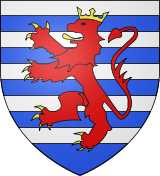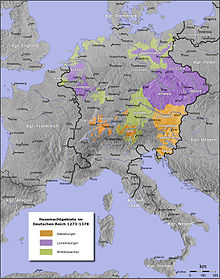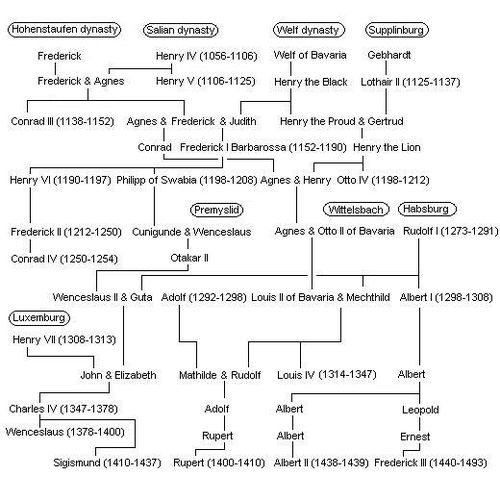- House of Luxembourg
-
Luxembourgs 
Coat of armsCountry Holy Roman Empire
Kingdom of Germany
Kingdom of Bohemia
County of LuxembourgAncestral house House of Limburg Titles Holy Roman Emperor
King of the Romans
King of Bohemia
Counts of LuxembourgFounder Henry V, Count of Luxembourg Final sovereign Sigismund, Holy Roman Emperor Founding 1247 Dissolution 1437 The House of Luxembourg was a late medieval German dynasty, which between 1308 and 1437 ruled the Holy Roman Empire, twice interrupted by the rivaling House of Wittelsbach.
Contents
History
It initially was a cadet branch of the ducal House of Limburg, when in 1247 Henry, younger son of Duke Waleran III inherited the County of Luxembourg upon the death of his mother Countess Ermesinde, a scion of the House of Namur. Her father, Count Henry IV of Luxembourg, was related on his mother's side with the Ardennes-Verdun dynasty (also called the Elder House of Luxembourg), which had ruled the county since the late 10th century.
Count Henry V's grandson Henry VII, Count of Luxembourg upon the death of his father Henry VI at the 1288 Battle of Worringen, was elected Rex Romanorum in 1308. The election was necessary after the Habsburg king Albert I of Germany had been murdered, and Henry, backed by his brother Prince-Archbishop Baldwin of Trier, prevailed against Count Charles of Valois. Henry arranged the marriage of his son John with the Přemyslid heiress Elisabeth of Bohemia in 1310, whereupon the House of Luxembourg gained the vast Kingdom of Bohemia as a significant power basis to compete with the Habsburg and Wittelsbach dynasties. One year after being crowned Holy Roman Emperor at Rome, Henry VII, still on campaign in Italy, died in 1313.
The Prince-electors, perturbed by the steep rise of the Luxembourgs, disregarded the claims raised by Henry's heir King John, and the rule over the Empire was assumed by the Wittelsbach duke Louis of Bavaria. John instead concentrated on securing his rule in Bohemia and gradually vassalized the Piast dukes of adjacent Silesia from 1327 until 1335. His son Charles IV, in 1346 again gained the Imperial crown, the most capable ruler of the Luxembourg dynasty, whose Golden Bull of 1356 served as a constitution of the Empire for centuries. Charles not only acquired the duchies of Brabant and Limburg in the west, but also the former March of Lusatia (Lower Lusatia) and even the Margraviate of Brandenburg in 1373, then holding two votes in the electoral college.
The family's decline began under Charles' son King Wenceslaus, who was deposed by the Prince-electors in 1400, who chose the Wittelsbach Elector Palatine Rupert. In 1410 the rule was assumed by Wenceslaus' brother Sigismund, who once again stabled the rule of the Luxembourgs and even contributed to end the Western Schism in 1417; however, with his death in 1437, the dynasty became extinct. He was succeeded by his son-in-law, the Habsburg archduke Albert V of Austria. The Habsburgs finally prevailed as Luxembourg heirs, ruling the Empire until their extinction upon the death of Maria Theresa in 1780.
Notable members
- Henry VII (1275–1313) — elected King of the Romans in 1308 succeeding assassinated Albert of Habsburg, crowned Holy Roman Emperor in 1312. Was succeeded by Louis IV from the House of Wittelsbach.
- Baldwin — brother of Henry, Prince-Archbishop of Trier and thereby Archchancellor of Burgundy 1307–54.
- John the Blind (1296–1346) — only son of Henry. Was enfeoffed with the Bohemia by his father in 1310, married the Přemyslid heiress Elisabeth of Bohemia and deposed the Bohemian king Henry the Carinthian.
- Charles IV (1316–78) — eldest son of John. Was elected King of the Romans in opposition to Louis IV in 1346 and succeeded his father as King of Bohemia in the same year, crowned Holy Roman Emperor in 1355. Most important emperor of the Late Middle Ages, famous for founding the Charles University in Prague and issuing the Golden Bull of 1356.
- John Henry, Margrave of Moravia — younger brother of Charles. Married Countess Margaret of Tyrol, daughter of Henry the Carinthian in 1330, Count of Tyrol from 1335 until his repudiation in 1341.
- Jobst of Moravia (1351–1411) — eldest son of John Henry. Margrave of Brandenburg 1388-1411, elected King of the Romans in 1410.
- John Henry, Margrave of Moravia — younger brother of Charles. Married Countess Margaret of Tyrol, daughter of Henry the Carinthian in 1330, Count of Tyrol from 1335 until his repudiation in 1341.
- Wenceslaus (1361–1419) — eldest surviving son of Charles. Margrave of Brandenburg 1373-1378, elected King of the Romans in 1376, succeeded his father as King of Bohemia in 1378. Declared deposed by the Prince-electors in 1400, was succeeded by Rupert of Wittelsbach.
- Sigismund (1368–1437) — younger son of Charles. Margrave of Brandenburg 1378-1388, King of Hungary from 1387 by his wife Mary of Anjou, elected King of the Romans in 1411,[1] succeeded his brother as King of Bohemia in 1419, crowned Holy Roman Emperor in 1433, left no male heirs.
- Elizabeth of Luxembourg, only child of Emperor Sigismund, married Archduke Albert V of Austria from the Albertinian line of the House of Habsburg in 1422, thereby queen consort of Hungary from 1437 as well as Queen of the Romans and queen consort of Bohemia from 1438 until Albert's death in 1439; the heiress who conveyed the major portion of the Luxembourg inheritance to the Habsburgs and, later, the Jagiellos through her daughter Elisabeth of Austria.
Luxemburg family tree
References
Categories:- Luxembourgian dynasty
- Luxembourgian noble families
- House of Limburg
- European royal families
- German noble families
- Belgian noble families
- Bohemian noble families
- Dutch noble families
- History of Luxembourg
- People in the history of Germany
- Holy Roman Emperors
- Noble families of the Holy Roman Empire
- Henry VII (1275–1313) — elected King of the Romans in 1308 succeeding assassinated Albert of Habsburg, crowned Holy Roman Emperor in 1312. Was succeeded by Louis IV from the House of Wittelsbach.
Wikimedia Foundation. 2010.


